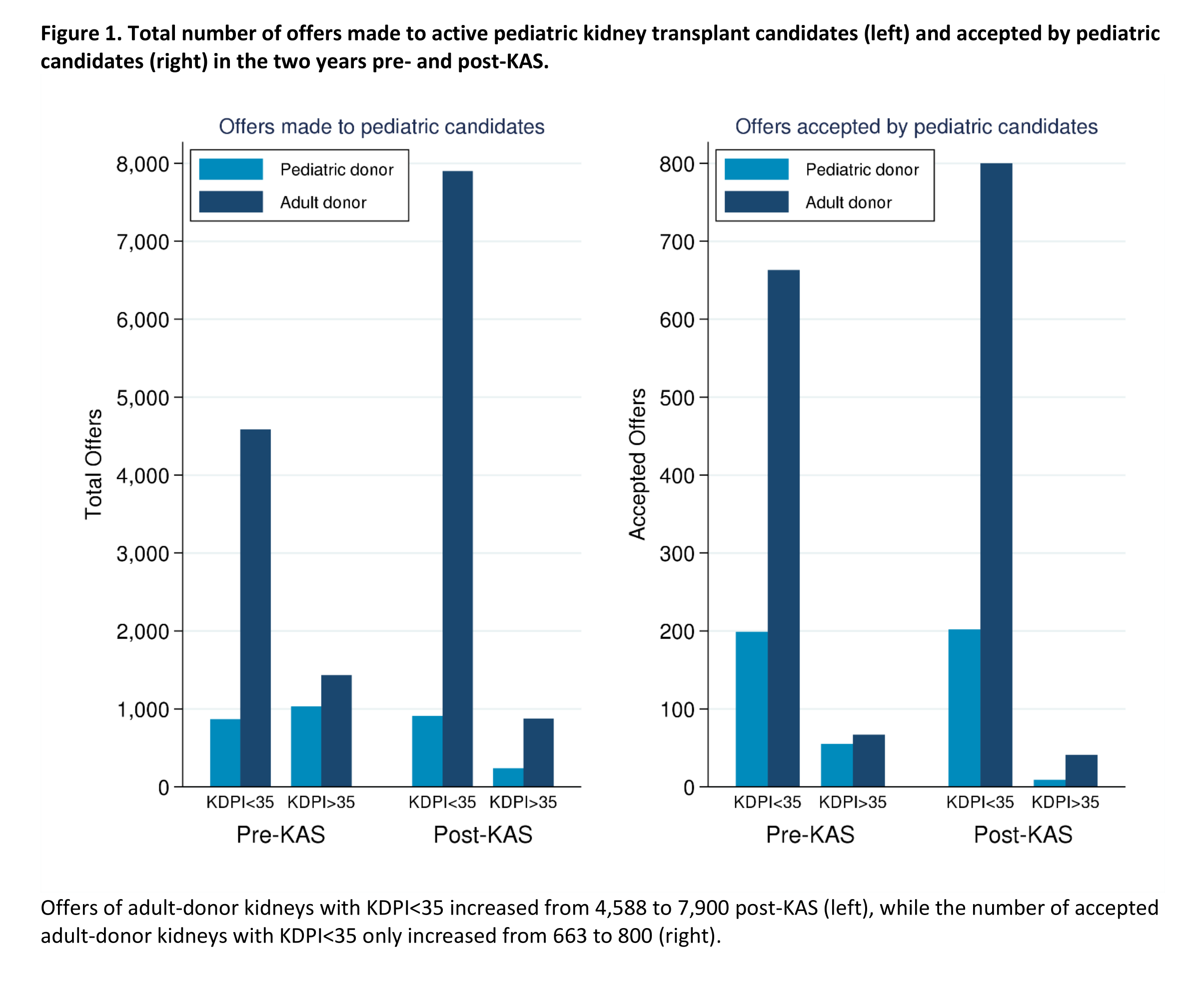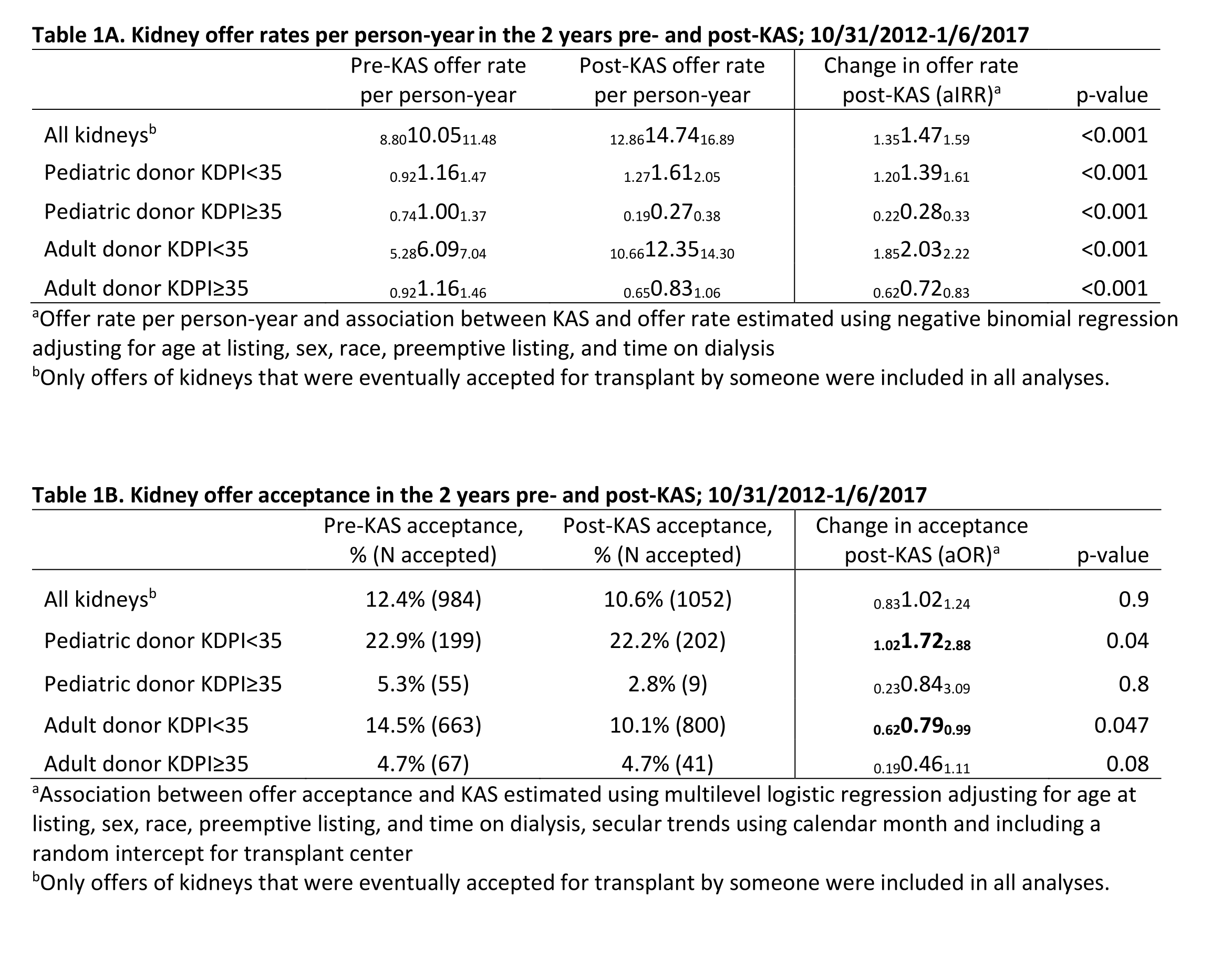Changes in Kidney Offer Acceptance for Pediatric Candidates Post-KAS
Johns Hopkins University, Baltimore, MD
Meeting: 2019 American Transplant Congress
Abstract number: 14
Keywords: Allocation, Kidney transplantation, Pediatric
Session Information
Session Name: Concurrent Session: Kidney Deceased Donor Allocation I
Session Type: Concurrent Session
Date: Sunday, June 2, 2019
Session Time: 2:30pm-4:00pm
 Presentation Time: 2:54pm-3:06pm
Presentation Time: 2:54pm-3:06pm
Location: Ballroom B
*Purpose:
Stakeholders have expressed concerns regarding kidney transplant rates for pediatric candidates under KAS. To better understand what might be driving potential declines in access, we studied offer patterns and acceptance practices before and after KAS.
*Methods:
We used SRTR kidney offer data to study 5300 active pediatric kidney-only transplant candidates on the waitlist between 10/31/2012-1/6/2017. We used negative binomial regression and multilevel logistic regression to estimate offer rates per person-year and compare the odds of accepting an offer in the 2 years before and after KAS (12/4/2014) adjusting for candidate age, sex, race, dialysis time, preemptive listing, and secular trends. Given changes in prioritization for pediatric candidates under KAS, we studied kidney offers of adult and pediatric donors with KDPI above and below 35.
*Results:
Pre-KAS, 7,925 offers were made to 1,632 candidates, and 984 (12.4%) were accepted. Post-KAS, 9,926 offers were made to 1,723 candidates, and 1,052 (10.6%) were accepted; the number of donors remained unchanged at 2,879 and 2,917 pre- and post-KAS. The offer rate increased from 10.0 to 14.7 per person-year post-KAS for kidneys overall, 6.1 to 12.4 per person-year for adult-donor kidneys with KDPI<35, and 1.2 to 1.6 per person-year for pediatric-donor kidneys with KDPI<35 (Table 1A, Figure 1). Among pediatric candidates who received an offer, however, the odds of acceptance decreased 21% post-KAS for adult-donor kidneys with KDPI<35 (aOR 0.620.790.99, p=0.047) and increased 1.7-fold for pediatric-donor kidneys with KDPI<35 (aOR 1.021.722.88, p=0.04) (Table 1B). Acceptance of adult and pediatric donor kidneys with KDPI≥35 remained unchanged post-KAS (p-values>0.1).
*Conclusions:
Pediatric candidates received more low-KDPI kidney offers from adult donors under KAS, yet offer acceptance declined. High prioritization of pediatric candidates might allow for increased selectivity, but the decision to decline an offer should be weighed against the consequences of remaining on dialysis for these patients.
To cite this abstract in AMA style:
Bowring M, Jackson K, Garonzik-Wang J, Segev D, Massie A. Changes in Kidney Offer Acceptance for Pediatric Candidates Post-KAS [abstract]. Am J Transplant. 2019; 19 (suppl 3). https://atcmeetingabstracts.com/abstract/changes-in-kidney-offer-acceptance-for-pediatric-candidates-post-kas/. Accessed December 25, 2025.« Back to 2019 American Transplant Congress


